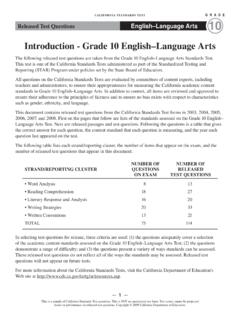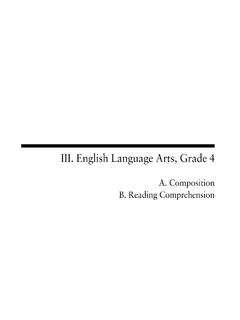Transcription of Introduction - Grade 9 English–Language Arts
1 CALIFORNIA STANDARDS TEST Grade Released Test Questions english language arts 9 Introduction - Grade 9 english language arts The following released test questions are taken from the Grade 9 english language arts Standards Test. This test is one of the California Standards Tests administered as part of the Standardized Testing and Reporting (STAR) Program under policies set by the State Board of Education. All questions on the California Standards Tests are evaluated by committees of content experts, including teachers and administrators, to ensure their appropriateness for measuring the California academic content standards in Grade 9 english language arts .
2 In addition to content, all items are reviewed and approved to ensure their adherence to the principles of fairness and to ensure no bias exists with respect to characteristics such as gender, ethnicity, and language . This document contains released test questions from the California Standards Test forms in 2003, 2004, 2005, 2006, 2007, and 2008. First on the pages that follow are lists of the standards assessed on the Grade 9 english language arts Test. Next are released passages and test questions. Following the questions is a table that gives the correct answer for each question, the content standard that each question is measuring, and the year each question last appeared on the test.
3 The following table lists each strand/reporting cluster, the number of items that appear on the exam, and the number of released test questions that appear in this document. NUMBER OF NUMBER OF STRAND/REPORTING CLUSTER QUESTIONS RELEASED ON EXAM TEST QUESTIONS Word Analysis 8 17 reading comprehension 18 27 Literary Response and Analysis 16 20 Writing Strategies 20 25 Written Conventions 13 25 TOTAL 75 114 In selecting test questions for release, three criteria are used: (1) the questions adequately cover a selection of the academic content standards assessed on the Grade 9 english language arts Test; (2) the questions demonstrate a range of difficulty; and (3) the questions present a variety of ways standards can be assessed.
4 These released test questions do not reflect all of the ways the standards may be assessed. Released test questions will not appear on future tests. For more information about the California Standards Tests, visit the California Department of Education s Web site at 1 This is a sample of California Standards Test questions. This is NOT an operational test form. Test scores cannot be projected based on performance on released test questions. Copyright 2009 California Department of Education. Grade CALIFORNIA STANDARDS TEST Released Test Questions english language arts 9 reading The reading portion of the Grade 9 California english language arts Standards Test has three strands/ reporting clusters: Word Analysis, reading comprehension , and Literary Response and Analysis.
5 Each of these strands/clusters is described below. The Word Analysis Strand/Cluster The following three California english language arts content standards are included in the Word Analysis strand/cluster and are represented in this booklet by 17 test questions for Grade 9. These questions represent only some ways in which these standards may be assessed on the Grade 9 California english language arts Standards Test. WORD ANALYSIS, FLUENCY, AND SYSTEMATIC VOCABULARY DEVELOPMENT: Students apply their knowledge of word origins to determine the meaning of new words encountered in reading materials and use those words accurately.
6 Vocabulary and Concept Development: Identify and use the literal and figurative meanings of words and understand word derivations. Vocabulary and Concept Development: Distinguish between the denotative and connotative meanings of words and interpret the connotative power of words. Vocabulary and Concept Development: Identify Greek, Roman, and Norse mythology and use the knowledge to understand the origin and meaning of new words ( , the word narcissistic drawn from the myth of Narcissus and Echo). 2 This is a sample of California Standards Test questions. This is NOT an operational test form.
7 Test scores cannot be projected based on performance on released test questions. Copyright 2009 California Department of Education. CALIFORNIA STANDARDS TEST Grade Released Test Questions english language arts 9 The reading comprehension Strand/Cluster The following seven California english language arts content standards are included in the reading comprehension strand/cluster and are represented in this booklet by 27 test questions for Grade 9. These questions represent only some ways in which these standards may be assessed on the Grade 9 California english language arts Standards Test. reading comprehension (FOCUS ON INFORMATIONAL MATERIALS): Students read and understand Grade -level-appropriate material.
8 They analyze the organizational patterns, arguments, and positions advanced. The selections in Recommended Readings in Literature, Grades Nine Through Twelve (1990) illustrate the quality and complexity of the materials to be read by students. In addition, by Grade twelve, students read two million words annually on their own, including a wide variety of classic and contemporary literature, magazines, newspapers, and online information. In grades nine and ten, students make substantial progress toward this goal. Structural Features of Informational Materials: Analyze the structure and format of functional workplace documents, including the graphics and headers, and explain how authors use the features to achieve their purposes.
9 Structural Features of Informational Materials: Prepare a bibliography of reference materials for a report using a variety of consumer, workplace, and public documents. comprehension and Analysis of Grade -Level-Appropriate Text: Generate relevant questions about readings on issues that can be researched. comprehension and Analysis of Grade -Level-Appropriate Text: Synthesize the content from several sources or works by a single author dealing with a single issue; paraphrase the ideas and connect them to other sources and related topics to demonstrate comprehension . comprehension and Analysis of Grade -Level-Appropriate Text: Demonstrate use of sophisticated learning tools by following technical directions ( , those found with graphic calculators and specialized software programs and in access guides to World Wide Web sites on the Internet).
10 Expository Critique: Critique the logic of functional documents by examining the sequence of information and procedures in anticipation of possible reader misunderstandings. Expository Critique: Evaluate the credibility of an author s argument or defense of a claim by critiquing the relationship between generalizations and evidence, the comprehensiveness of evidence, and the way in which the author s intent affects the structure and tone of the text ( , in professional journals, editorials, political speeches, primary source material). 3 This is a sample of California Standards Test questions.







